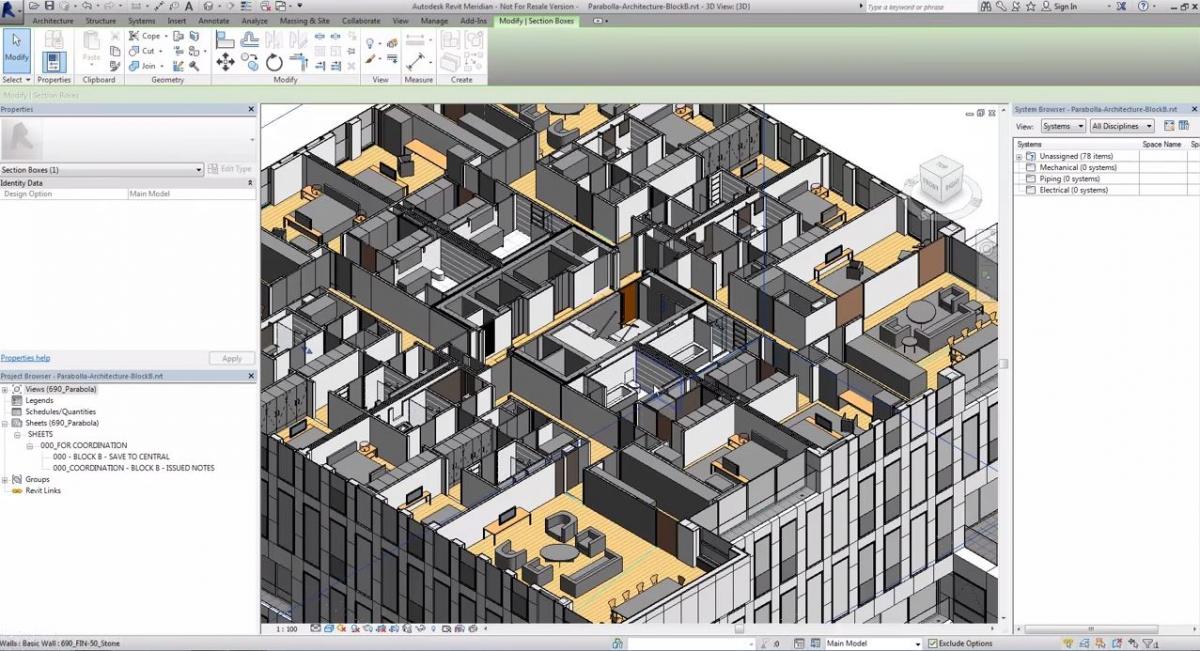
When we last discussed Revit, it was to show how its processes can allow prefabrication of building components, particularly MEP equipment.
A new version of Revit brought new tools and features to users when it launched earlier this year, most of which are specifically focused on helping you create better designs that can be sent right to construction or prefabrication. Here’s a roundup of what’s new in Revit 2015.
1. Sketchy Lines. Do you like your models to look like actual drawings? Hand-drawn 3D model is an oxymoron, but thanks to a new feature you can make your model look like a drawing in Revit. The artistic visual effect of accurate “sketchy” lines has been added in Revit 2015. Whether it’s a wireframe, shaded view, consistent view, or realistic, you can still make consistently sketchy-looking lines from the graphic display options. CADClips explains how.
2. Reordering Family Parameters. Users now have the ability to sort family file parameters within each parameter group according to their needs. In previous versions of Revit, you had to come up with ways of organizing parameters with no ability to reorder. On more complicated families, it was often difficult to sort through the parameters that you wanted to edit. BIMopedia shows how.
3. Revision Cloud Annotations. By selecting Revision Cloud from the annotation tab, you can place clouds throughout a sheet set to note revisions. These automatically get included in a revision schedule if one is included. You can also remove revisions in batches using clouds. See how from Autodesk Building Solutions.
4. Reinforcement Presentation. We talked about creating shop drawings for construction in the blog about prefabrication. The changes for reinforced concrete detailing in Revit 2015 are robust. There are new presentation styles for steel reinforcing bar (rebar). The goal is to give the reinforced concrete detailer a better set of tools for the production of 2D reinforced concrete drawings and accurate schedules. Previously, the reinforced concrete drawings would show every bar, but the user now has the choice of selecting any of the bars to show. This feature allows the proper presentation of bars in plans and elevations using a similar system to AutoCAD Structural Detailing. Autodesk Building Solutions’ video shows how.
5. Changing Existing View Presentations. You can change view references after the views have been created in Revit 2015. It works for floor plans, sections, and elevation views as well as detail and drafting views. Before, you could not select a view and change existing view references for other ones from the contextual pull-down list. Ideate explains how for all views.
6. Trim and Extend Walls. In Revit 2015, you can now use a selection box to select multiple elements to trim or extend to a boundary defined by another element. This is particularly useful for walls where previously you would have to lay out each individually and not trim or extend them as a group. You are still able to select individual elements to trim or extend. David Light’s video explains how.
7. Scheduling Wall Heights. Another boon to structural engineers working with walls is the ability to schedule more wall parameters in Revit 2015. You can schedule wall parameters for multiple ceiling and roof heights thanks to the new wall parameters; just be aware that your wall’s unconnected height might not always be what you want it to be. Check your new parameters. BIMopedia has the details.
8. MEP Tag Improvements. When you move a tag element or drag a tag head in Revit MEP 2015, the tag leader and elbow adjustment behaviors are now consistent with that of the tag leaders. There’s also an instance property called “elevation at top” that’s been added to isolated foundations, wall foundations, and foundation slabs to specify the highest point or plane of the foundation. See how to use these improvements from Ideate.
By Jeff Yoders
This article was originally published on Line/Shape/Space, an official Autodesk blog, and is reprinted here with minor modifications and with kind permission.
Featured image courtesy of BIMopedia.
















































